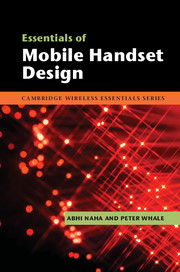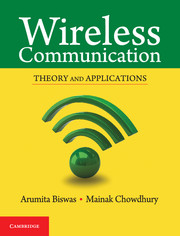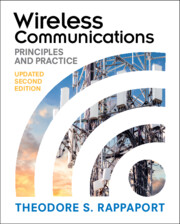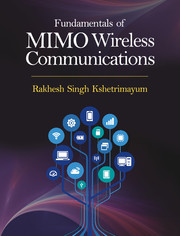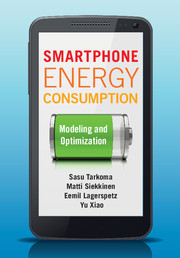Essentials of Mobile Handset Design
Discover what is involved in designing the world's most popular and advanced consumer product to date - the phone in your pocket. With this essential guide you will learn how the dynamics of the market, and the pace of technology innovation, constantly create new opportunities which design teams utilize to develop new products that delight and surprise us. Explore core technology building blocks, such as chipsets and software components, and see how these components are built together through the design lifecycle to create unique handset designs. Learn key design principles to reduce design time and cost, and best practice guidelines to maximize opportunities to create a successful product. A range of real-world case studies are included to illustrate key insights. Finally, emerging trends in the handset industry are identified, and the global impact those trends could have on future devices is discussed.
- Includes the step-by-step mobile handset design principles and guidelines required to create a successful handset design
- Enables readers to understand the market dynamics that drive handset design, such as the pace of improvements in chipset integration, low power operation, high volume manufacturing and customisation for market niches
- Provides details of the key components of a mobile handset and the design factors which drive innovation and technology development
Reviews & endorsements
"...I have learned a lot from this book...is an enjoyable read and contains many valuable lessons on product development. This book is also a comprehensive, albeit, high level, tour of cell phone hardware, software, and networking. I think this book would be very useful to engineers, educators, and marketing people." - Alfy Riddle, IEEE Microwave Magazine, September/October 2013
Product details
October 2012Hardback
9781107010048
249 pages
235 × 156 × 17 mm
0.53kg
25 b/w illus. 5 tables
Available
Table of Contents
- Preface
- Acknowledgements
- 1. Beginnings:
- 1.1. Development of the first mobile handset
- 1.2. Generations of mobile communication capability
- 1.3. The digital revolution -2G
- 1.4. High-speed data - 3G
- 1.5. Mobile broadband - 4G
- 1.6. Conclusion
- 1.7. Timeline of the mobile phone
- 2. Design influences:
- 2.1. Core design influence - engagement value
- 2.2. Trends
- 2.3. Desirability
- 2.4. User journey
- 2.5. Usability
- 2.6. Corporate user versus personal user
- 2.7. Business models
- 2.8. New entrants into the mobile industry
- 2.9. Content
- 2.10. Applications and services
- 2.11. Internet
- 2.12. Innovation in handset design
- 2.13. Legislation
- 2.14. Conclusion
- 3. Design architecture:
- 3.1. Design perspective
- 3.2. Physical view - a product teardown
- 3.3. Standards view
- 3.4. Hardware architecture view
- 3.5. Software architecture view
- 3.6. Manufacturer view
- 3.7. Operator view
- 3.8. Summary
- 4. Hardware design:
- 4.1. Introduction
- 4.2. Helicopter view
- 4.3. The radio spectrum
- 4.4. Radio chipset design
- 4.5. Digital chipset design
- 4.6. Baseband cellular modem design
- 4.7. Mobile application processor design
- 4.8. Multimedia processor design
- 4.9. Peripheral component design
- 4.10. Conclusion
- 5. Software design:
- 5.1. Application software design
- 5.2. Protocol stack software design
- 5.3. Physical layer software design
- 5.4. Mobile operating systems and execution environments
- 5.5. Conclusion
- 6. Product design:
- 6.1. Introduction
- 6.2. The design process
- 6.3. Planning a handset design program
- 6.4. Brand DNA design
- 6.5. Visual and desirable design
- 6.6. User experience design
- 6.7. Industrial design
- 6.8. Mechanical design engineering
- 6.9. Hardware design engineering
- 6.10. Software platform design
- 6.11. Manufacturing production
- 6.12. Testing and qualification
- 6.13. Channel marketing design
- 6.14. Case study: capacitive touchscreens in mobile handsets
- 6.15. Using the design process as a strategic tool for innovation
- 6.16. Inclusive design and accessibility
- 6.17. Conclusion
- 7. Future trends:
- 7.1. Introduction
- 7.2. The journey
- 7.3. Designing for the environmental footprint
- 7.4. The 'smart' journey
- 7.5. The mobile home
- 7.6. Near-field sensing
- 7.7. Augmented reality
- 7.8. Wireless power charging
- 7.9. Case study: wireless charging in smart devices
- 7.10. Social values and shared experiences
- 7.11. Efficient handset platforms
- 7.12. Handsets and the retail experience
- 7.13. Summary
- 7.14. Conclusion
- 8. Conclusion
- Appendix: user interaction and experience design phases
- Glossary
- Index.

